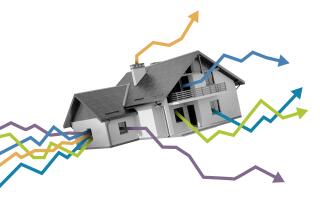Home Prices at Record High
- Share via
Home prices in Los Angeles and Orange counties set records -- yet again -- in December, though the pace of sales slowed as the supply of available houses dwindled, data released Monday showed.
The median price in Los Angeles County rose 21.2% to $418,000 from a year earlier but was essentially flat from the month before. In Orange County, the December median gained 18% to $551,000 and was up less than 2% from November’s $541,000, according to real estate firm DataQuick Information Systems.
For the full year, the price trends were similar. Both counties saw their median prices rise 24%, which was above the 20% rate of appreciation in 2003. The median is the point at which half of all houses and condominiums sold for more and half for less.
As for sales in December, the number of transactions year over year slipped 7.4% to 10,242 in Los Angeles County and dropped 10.2% to 4,214 in Orange County, DataQuick said.
For 2004, sales for all types of homes decreased 3.3% in L.A. County and 11.5% in Orange County.
“What this shows is that the sales numbers are off their peaks,” said John Karevoll, DataQuick’s chief analyst. “I’m not sure what more than that it means.”
Indeed, getting a handle on Southern California real estate trends hasn’t been easy lately.
“This market,” said Los Angeles real estate agent Brian Moore, “has been like riding a wild horse.”
Last year began with less than a month’s worth of homes available and prices appreciating at 25% year over year in L.A. and Orange counties. With high demand and limited supply, prices continued to hit records; by spring, Orange County’s median price had sprinted past the half-million-dollar mark.
Then in the second quarter, sales began to slow somewhat as mortgage rates crept higher.
At the same time, sensing a possible peak in pricing power, a growing number of homeowners rushed to plant “for sale” signs on their lawns in the hope of cashing out at top dollar.
By fall, the stock of homes had swelled to a 3.5-month supply, giving buyers more choices -- and more leverage at the negotiating table. That in turn prompted some sellers to pull their listings, and inventories shriveled.
At the end of December, inventory in Los Angeles and Orange counties stood at a 2.75-month supply as the average number of days on the market shrank to 41, down from a peak of 56 in the fall, according to Real Data Strategies, a Brea-based firm that analyzes regional real estate listings on a seasonally adjusted basis.
“What is interesting is that in 2004 people thought the bottom had fallen out,” said Patrick Veling, Real Data Strategies’ president. “That certainly did not come to pass.”
If anything, Veling said, prospective buyers who decided to wait for prices to fall might be out of luck. He predicts 18 more months of a hardy housing market, with prices rising albeit at a slower pace -- by 10% to 14% year over year -- but still above the rate of inflation.
“There’s a greater sense of normalcy in the market,” Veling said, “but I see it going nowhere but up.”
That’s worrisome to some experts. As prices increase, fewer house hunters can afford to buy, which is evident in the slowing pace of sales, said broker Jim Joseph, owner of Century 21 Grisham Joseph in Whittier.
Interest rates have ticked higher, putting pressure on the mortgage market. Combined with higher prices, Joseph said, those factors are causing “head wind that has taken buyers out of the market.”
Elsewhere in Southern California, the median home price in San Diego County was $491,000 in December, a 21.2% increase from December 2003, and was flat from the previous month, DataQuick reported. Sales fell 12% to 4,807.
For the full year, San Diego’s median increased 21% and sales rose 2.3% from 2003. Data for Riverside and San Bernardino counties are expected today.
DataQuick’s numbers comprise all recorded transactions in a given period and aren’t seasonally adjusted.
More to Read
Inside the business of entertainment
The Wide Shot brings you news, analysis and insights on everything from streaming wars to production — and what it all means for the future.
You may occasionally receive promotional content from the Los Angeles Times.









